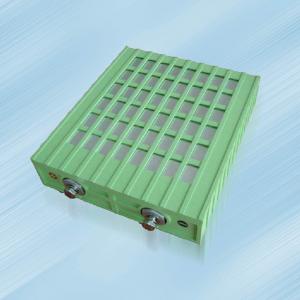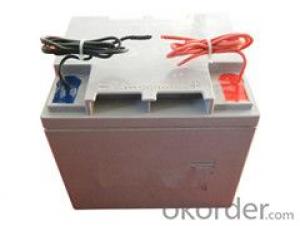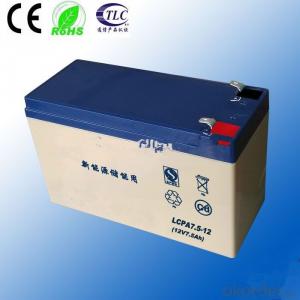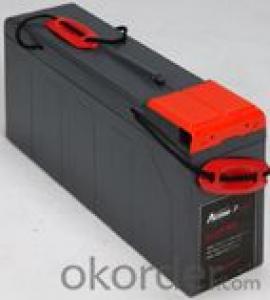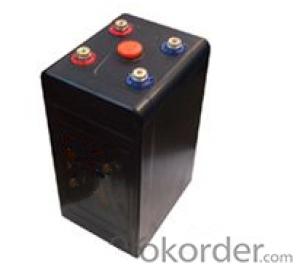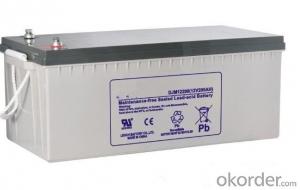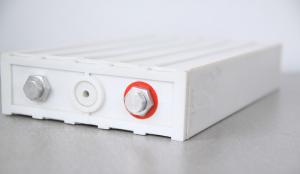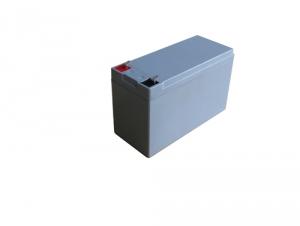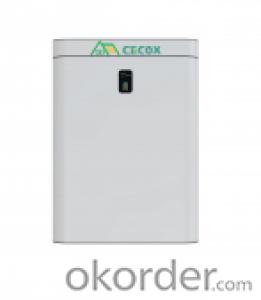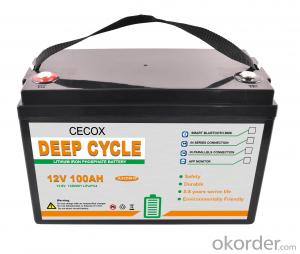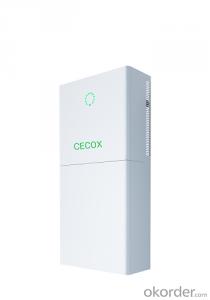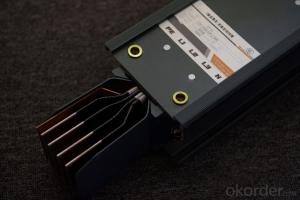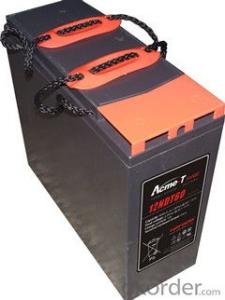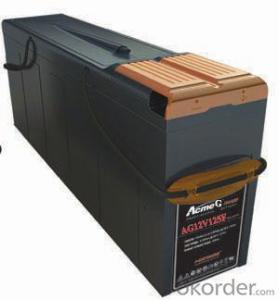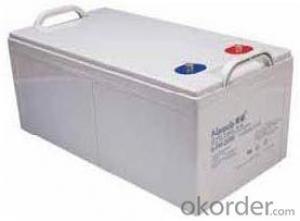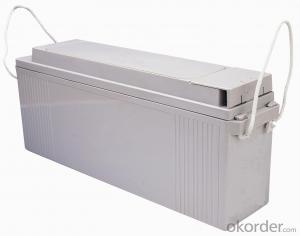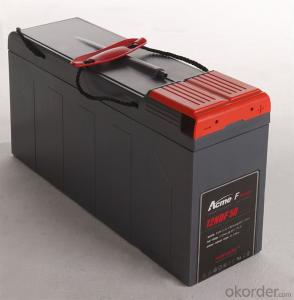Gel Technology Battery Ares(OPzV) Series 16OPzV 2000
- Loading Port:
- Shanghai
- Payment Terms:
- TT OR LC
- Min Order Qty:
- 1000 unit
- Supply Capability:
- 5000000 unit/month
OKorder Service Pledge
OKorder Financial Service
You Might Also Like
Gel Technology Battery Ares(OPzV) Series Introduction
Ares(OPzV) range battery adopts traditional gel technology .
The products are designed as standby power for communication, power, military and broadcast and television system with excellent deep cycle performance. The design float life is 18+ at 77oF(25oC)
The Ares(OPzV) range batteries are ensured the quality with NARADA's QA system according to the ISO9001 and ISO14001 standard.


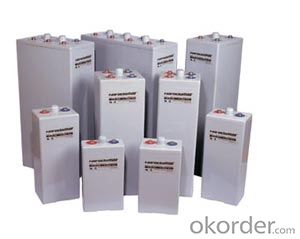
Type: | 16OPzV 2000 | |
Voltage: | 2V | |
Nominal Capacity: | 2000Ah(C10) | 2000Ah(10 hours rate:) |
Length: | 399mm | |
Width: | 212mm | |
Height: | 770mm | |
Height with termial: | 802mm | |
Weight: | 155Kg |
Gel Technology Battery Ares(OPzV) Series Technical Feature:
Traditional gel technology
18+ years design life under floating application and cycle life is above 1200 at 80% DOD under temperature 25 oC.
Reliable seal performance, no acid spillage, recombination efficiency reach 99.9%
Initial capacity above 100%, the remaining capacity above 94% after storage for 3 months (25oC)
low float charge voltage. design (2.23V/cell, 25oC), extremely consistent float charge voltage
Flexible connectors and convenient installation
Gel Technology Battery Ares(OPzV) Series Compliant Standards :
IEC60896-21/22
Din standard
UL
Manufactured under system ISO9001(TUV) and ISO14001(DNV) by Narada
Gel Technology Battery Ares(OPzV) Series Battery Installation Compliant with:
EN 50272-2 or local equivalents
Gel Technology Battery Ares(OPzV) Series Main Application:
Telecommunications
Motive power applications
Railway and mining markets
Uninterruptible power supply (UPS)
Solar energy storage application
Other applications to provide integrated stored energy system
Gel Technology Battery Ares(OPzV) Series Products Characteristics:
Recommended float charge voltage for 2V battery: 2.23Vpc at 25oC(77oF)
Self discharge rate :< 2% per month at 25oC(77oF)
Design life: 18+ years at 25oC(77oF)
Shelf life: 6 months at 25oC(77oF)
Valve regulated system, no water addition needed
FAQ
![]() What is sulfation of batteries?
What is sulfation of batteries?
Sulfation is the formation or deposit of lead sulfate on the surface and in the pores of the active material of the batteries' lead plates. If the sulfation becomes excessive and forms large crystals on the plates, the battery will not operate efficiently and may not work at all. Common causes of battery sulfation are standing a long time in a discharged condition, operating at excessive temperatures, and prolonged under or over charging.
![]() How long a battery can last?
How long a battery can last?
The service design life of a battery are vary considerably with how it is used, how it is maintained and charged, temperature, and other factors.
![]() Do batteries self-discharge when not in use?
Do batteries self-discharge when not in use?
All batteries, regardless of their chemistry, self-discharge. The rate of self-discharge depends both on the type of battery and the storage temperature the batteries are exposed to. However, for a good estimate, Narada batteries self-discharge approximately 4% per week at 80ĄăF.
- Q:How does battery activation work?
- If you are talking about dry batteries, that is, to add sulfuric acid can use the battery (commonly known as water bottles), then it is because the long-term storage so that a high degree of oxidation of the negative board, plus acid will be a high temperature, Low, you can add acid in the pool after the addition of a small current for a long time to charge, you can solve. Generally with 0.05C charge to 3 times can be.
- Q:How to repair the battery?
- Charge the battery at constant voltage. It is the beginning of the time, using 0.1C ~ 0.25C current charge, to 16.2V later, by reducing the current method to maintain the charging voltage, until the charge current drops to 0.03C when the stop charging.
- Q:The role of the battery?
- Battery is a kind of battery, its role is to be able to save the limited power, in the right place to make 6v4ah emergency light battery. Its working principle is to convert chemical energy into electricity.
- Q:How to deal with waste batteries?
- The rest of the various types of waste batteries are generally shipped to a special toxic, hazardous landfill, but this approach not only cost too much but also cause waste, because there are many useful raw materials available.
- Q:80ah how much battery storage capacity?
- 0AH storage is 80AH ah If the actual storage capacity will have to see the brand. I have seen 100AH only 24 pound. This is not even 60AH.
- Q:What are the advantages of maintenance-free batteries?
- Maintenance-free battery because of its normal charging voltage, the electrolyte only produce a small amount of gas, so throughout the use of the need for the addition of distilled water, in the normal charging system, do not need to remove the charge from the removal. But in the maintenance of the proportion of its electrolyte should be checked.
- Q:How is the capacity of the battery defined?
- General circuit has a battery protection circuit, once the battery voltage is less than 10.8V will automatically cut off the electricity to prevent the battery because of over-discharge and damage. (Nominal value of 12V battery internal six cell grid) with the battery discharge current multiplied by the discharge time to express how much energy the battery can store, is a very image of a measure. The greater the value of the battery, indicating that the battery can store more energy. But does not mean that the battery can use such a large current discharge.
- Q:How should the battery be well maintained?
- Electrolyte density This is to evaluate whether the battery charge is normal, whether the aging of the important parameters, the use of density meter or electrolyte density tester can be measured. If the electrolyte density is too small, you need to charge. And the electrolyte concentration is too thick or too thin to a certain extent, it means that such as the occurrence of plate vulcanization, short circuit or overcharge phenomenon, this time on the need for maintenance.
- Q:Lead-acid battery how to maintain?
- Open the rubber cap, exposing the exhaust raft, you can see the battery inside, some of the battery exhaust cutting can be unscrewed.
- Q:Maintenance-free battery how to detect it?
- Do not always check the color of the electric eye for maintenance-free batteries. Green for the full power; black for the lack of electricity, need to be added to charge; gray or light yellow for the electrolyte is insufficient, because maintenance-free battery can not add liquid, should immediately replace the battery.
1. Manufacturer Overview |
|
|---|---|
| Location | |
| Year Established | |
| Annual Output Value | |
| Main Markets | |
| Company Certifications | |
2. Manufacturer Certificates |
|
|---|---|
| a) Certification Name | |
| Range | |
| Reference | |
| Validity Period | |
3. Manufacturer Capability |
|
|---|---|
| a)Trade Capacity | |
| Nearest Port | |
| Export Percentage | |
| No.of Employees in Trade Department | |
| Language Spoken: | |
| b)Factory Information | |
| Factory Size: | |
| No. of Production Lines | |
| Contract Manufacturing | |
| Product Price Range | |
Send your message to us
Gel Technology Battery Ares(OPzV) Series 16OPzV 2000
- Loading Port:
- Shanghai
- Payment Terms:
- TT OR LC
- Min Order Qty:
- 1000 unit
- Supply Capability:
- 5000000 unit/month
OKorder Service Pledge
OKorder Financial Service
Similar products
New products
Hot products






